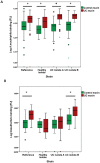A Preliminary Study Examining the Binding Capacity of Akkermansia muciniphila and Desulfovibrio spp., to Colonic Mucin in Health and Ulcerative Colitis
- PMID: 26491870
- PMCID: PMC4619660
- DOI: 10.1371/journal.pone.0135280
A Preliminary Study Examining the Binding Capacity of Akkermansia muciniphila and Desulfovibrio spp., to Colonic Mucin in Health and Ulcerative Colitis
Abstract
Background: Akkermansia muciniphila and Desulfovibrio spp. are commensal microbes colonising the mucus gel layer of the colon. Both species have the capacity to utilise colonic mucin as a substrate. A. muciniphila degrades colonic mucin, while Desulfovibrio spp. metabolise the sulfate moiety of sulfated mucins. Altered abundances of these microorganisms have been reported in ulcerative colitis (UC). However their capacity to bind to human colonic mucin, and whether this binding capacity is affected by changes in mucin associated with UC, remain to be defined.
Methods: Mucin was isolated from resected colon from control patients undergoing resection for colonic cancer (n = 7) and patients undergoing resection for UC (n = 5). Isolated mucin was purified and printed onto mucin microarrays. Binding of reference strains and three clinical isolates of A. muciniphila and Desulfovibrio spp. to purified mucin was investigated.
Results: Both A. muciniphila and Desulfovibro spp. bound to mucin. The reference strain and all clinical isolates of A. muciniphila showed increased binding capacity for UC mucin (p < .005). The Desulfovibrio reference strain showed increased affinity for UC mucin. The mucin binding profiles of clinical isolates of Desulfovibrio spp. were specific to each isolate. Two isolates showed no difference in binding. One UC isolate bound with increased affinity to UC mucin (p < .005).
Conclusion: These preliminary data suggest that differences exist in the mucin binding capacity of isolates of A. muciniphila and Desulfovibrio spp. This study highlights the mucin microarray platform as a means of studying the ability of bacteria to interact with colonic mucin in health and disease.
Conflict of interest statement
Figures




Similar articles
-
Correlations between colonic crypt mucin chemotype, inflammatory grade and Desulfovibrio species in ulcerative colitis.Colorectal Dis. 2014 May;16(5):O161-9. doi: 10.1111/codi.12503. Colorectal Dis. 2014. PMID: 24345279
-
The abundance of Akkermansia muciniphila and its relationship with sulphated colonic mucins in health and ulcerative colitis.Sci Rep. 2019 Oct 30;9(1):15683. doi: 10.1038/s41598-019-51878-3. Sci Rep. 2019. PMID: 31666581 Free PMC article.
-
In vitro colonisation of the distal colon by Akkermansia muciniphila is largely mucin and pH dependent.Benef Microbes. 2017 Feb 7;8(1):81-96. doi: 10.3920/BM2016.0013. Epub 2016 Nov 8. Benef Microbes. 2017. PMID: 27824274
-
Influences of the colonic microbiome on the mucous gel layer in ulcerative colitis.Gut Microbes. 2014 May-Jun;5(3):277-85. doi: 10.4161/gmic.28793. Epub 2014 Apr 8. Gut Microbes. 2014. PMID: 24714392 Free PMC article. Review.
-
Akkermansia muciniphila in the Human Gastrointestinal Tract: When, Where, and How?Microorganisms. 2018 Jul 23;6(3):75. doi: 10.3390/microorganisms6030075. Microorganisms. 2018. PMID: 30041463 Free PMC article. Review.
Cited by
-
The Timing Effects of Soy Protein Intake on Mice Gut Microbiota.Nutrients. 2019 Dec 27;12(1):87. doi: 10.3390/nu12010087. Nutrients. 2019. PMID: 31892229 Free PMC article.
-
Strain-specific effects of Desulfovibrio on neurodegeneration and oxidative stress in a Caenorhabditis elegans PD model.NPJ Parkinsons Dis. 2025 Aug 11;11(1):236. doi: 10.1038/s41531-025-01102-z. NPJ Parkinsons Dis. 2025. PMID: 40790298 Free PMC article.
-
Notch Signaling Pathway Is Activated by Sulfate Reducing Bacteria.Front Cell Infect Microbiol. 2021 Jul 15;11:695299. doi: 10.3389/fcimb.2021.695299. eCollection 2021. Front Cell Infect Microbiol. 2021. PMID: 34336718 Free PMC article.
-
Mechanisms underlying delirium in patients with critical illness.Front Aging Neurosci. 2024 Sep 26;16:1446523. doi: 10.3389/fnagi.2024.1446523. eCollection 2024. Front Aging Neurosci. 2024. PMID: 39391586 Free PMC article. Review.
-
Desulfovibrio Bacteria Are Associated With Parkinson's Disease.Front Cell Infect Microbiol. 2021 May 3;11:652617. doi: 10.3389/fcimb.2021.652617. eCollection 2021. Front Cell Infect Microbiol. 2021. PMID: 34012926 Free PMC article.
References
-
- Johansson ME, Larsson JM, Hansson GC. The two mucus layers of colon are organized by the MUC2 mucin, whereas the outer layer is a legislator of host-microbial interactions. Proceedings of the National Academy of Sciences of the United States of America. 2011;108 Suppl 1:4659–65. 10.1073/pnas.1006451107 - DOI - PMC - PubMed
-
- Backhed F, Ley RE, Sonnenburg JL, Peterson DA, Gordon JI. Host-bacterial mutualism in the human intestine. Science (New York, NY). 2005;307(5717):1915–20. - PubMed
-
- Ouwerkerk JP, de Vos WM, Belzer C. Glycobiome: bacteria and mucus at the epithelial interface. Best practice & research Clinical gastroenterology. 2013;27(1):25–38. - PubMed
Publication types
MeSH terms
Substances
LinkOut - more resources
Full Text Sources
Other Literature Sources
Medical
Molecular Biology Databases
Miscellaneous

